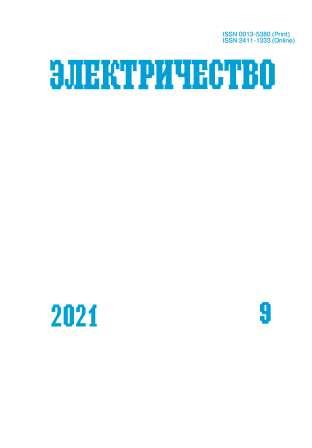Electrical Strength Estimation for Support Insulators under Pollution and Moistening Conditions
DOI:
https://doi.org/10.24160/0013-5380-2021-9-21-30Keywords:
support insulators, creepage distance to insulation height ratio, electrical strength estimation, pollution degreeAbstract
Based on the known theoretical concepts about the partial arc discharge development process and the data on the main design features of support insulators, numerical studies of their electrical strength under pollution and moistening conditions were carried out. The conditions under which the electrical strength of insulators can or cannot achieve its maximum possible value were analyzed. It is shown that the highest electrical strength of contaminated insulators is obtained at the optimal value of the ratio of the creepage distance to the height of the insulators along their insulating part (L/H)opt. The value of (L/H)opt is determined by the edge profile design features. As a rule, for insulators with a simple edge profile, the value of (L/H)opt = 2.45, and for insulators with a complex edge profile (L/H)opt = 3.1. In the region L/H ≤ (L/H)opt the effective use of the creepage distance by the discharge channel is ensured. It is shown that excessive increasing of the L/H ratio above the optimal value leads to inefficient use of the creepage distance by the discharge channel, which entails a noticeable decrease in the electrical strength of insulators. By using the proposed calculation estimates, it becomes possible to a priori determine the expediency of applying a particular insulator for being used in areas with various normalized pollution degrees.
References
2. Gutman I.Yu., Kinevsky V.R., Trifonov V.Z., et al. Electric strength of polluted EHV insulation, CIGRE, 1988, Rep. 33–08.
3. Rizk F.A.M., Rezazada A.Q. Modelling of altitude effects on a.c. flashover of polluted high voltage insulators. – IEEE Trans. on Power Delivery, 1997, vol. 12, No. 2, pp. 810 – 822.
4. CIGRE Technical Brochure. Polluted insulators: a review of current knowledge, TF 33.04.01, June 2000, 186 р.
5. Александров Г.Н., Иванов В.Л., Кизеветтер В.Е. Электрическая прочность наружной высоковольтной изоляции. Л.: Энергия, 1969, 240 с.
6. Корявин А.Р. Проблемы выбора внешней изоляции для работы в условиях загрязнения. – Электричество, 2017, № 4, с. 22–30.
7. Годулян В.В., Трифонов В.З., Остапенко Е.И. и др. Электрическая прочность аппаратной изоляции сверхвысокого напряжения в условиях загрязнения. – Электротехника, 2004, № 2, с. 8–12.
8. Электрическая прочность внешней изоляции /Под ред. О.В. Волковой, А.Р. Корявина. М.: Знак, 2006, 388 с.
9. Корявин А.Р. Оценка эффективной длины пути утечки опорных изоляторов в условиях загрязнения и увлажнения. – Электричество, 2018, № 1, с. 22–30.
10. Корявин А.Р. Электрическая прочность внешней изоляции: учебное пособие. М.: Изд-во МЭИ, 2018, 224 с.
11. ГОСТ Р 55195–2012. Электрооборудование и электроустановки переменного тока на напряжение от 1 до 750 кВ. Требования к электрической прочности изоляции. М.: Стандартинформ, 2014, 48 с.
12. ГОСТ 9920-89. Электроустановки переменного тока на напряжение от 3 до 750 кВ. Длина пути утечки внешней изоляции. М.: Стандартинформ, 2008, 6 с.
#
1. Godulyan V.V., Ostapenko E.I., Trifonov V.Z. Elektricheskaya prochnost' izolyatsii elektrooborudovaniya vysokogo napryazheniya. Sbornik nauchnyh trudov VEI – in Russ. (Electrical Insulation Strength of High-Voltage Electrical Equipment. Collection of Scientific Works of the AREI), 1989, с. 43–48.
2. Gutman I.Yu., Kinevsky V.R., Trifonov V.Z., et al. Electric strength of polluted EHV insulation, CIGRE, 1988, Rep. 33–08.
3. Rizk F.A.M., Rezazada A.Q. Modelling of altitude effects on a.c. flashover of polluted high voltage insulators. – IEEE Trans. on Power Delivery, 1997, vol. 12, No. 2, pp. 810 – 822.
4. CIGRE Technical Brochure. Polluted insulators: a review of current knowledge, TF 33.04.01, June 2000, 186 р.
5. Aleksandrov G.N., Ivanov V.L., Kizevetter V.E. Elektricheskaya prochnost' naruzhnoy vysokovol'tnoy izolyatsii (Electrical strength of external HV insulation). L.: Energiya, 1969, 240 p.
6. Koryavin A.R. Elektrichestvo – in Russ. (Electricity), 2017, No. 4, pp. 22–30.
7. Godulyan V.V., Trifonov V.Z., Ostapenko E.I., et al. Electrotekhnika – in Russ. (Electrical Engineering), 2004, No. 2, pp. 8–12.
8. Elektricheskaya prochnost' vneshney izolyatsii (Electrical strength of external insulation) / Under ed. O.V. Volkova, A.R. Koryavin. M.: Znak, 2006, 388 p.
9. Koryavin A.R. Elektrichestvo – in Russ. (Electricity), 2018, No. 1, pp. 22–30.
10. Koryavin A.R. Elektricheskaya prochnost' vneshney izolyatsii: uchebnoe posobie (Electrical strength of external insulation: a textbook). М.: Izd-vо МEI, 2018, 224 p.
11. GOST R 55195–2012. Elektrooborudovanie i elektroustanovki peremennogo toka na napryazhenie ot 1 do 750 kV. Trebovaniya k elektricheskoy prochnosti izolyatsii (Electrical equipment and installa-tions for a.c. voltages from 1 up to 750 kV. Requirements for dielectric strength of insulation). M.: Standartinform, 2014, 48 p.
12. GOST 9920-89. Elektroustanovki peremennogo toka na napryazhenie ot 3 do 750 kV. Dlina puti utechki vneshney izolyatsii (А.с. electrical installations for voltage from 3 to 750 kV. Creepage distance of external insulation). М.: Standartinform, 2008, 6 с.




